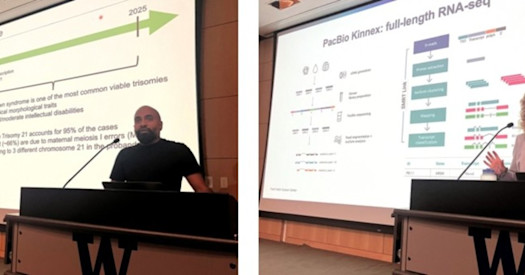 Christian Gallardo, Ph.D., a senior staff scientist at Seattle Children's Research Institute, discusses his work on HIV at the Long-Read Sequencing Symposium.
Christian Gallardo, Ph.D., a senior staff scientist at Seattle Children's Research Institute, discusses his work on HIV at the Long-Read Sequencing Symposium.
The goal of this symposium is to bring together Seattle-area users of long-read sequencing to learn from each other, build new collaborations, and to explore potential synergies among users. Was that goal met?
Dr. Miller: Yes, absolutely. Several participants at the reception after the symposium told me, “I enjoyed it because I did not know about X or Y,” meaning the person did not know that a presenter was working on a certain research project. That tells me people did learn about long-read sequencing-based work going on in the Seattle area that they were not aware of previously. At a high level, we certainly met that goal, but of course, I will be continuing to think about ways we can make more connections among users of long read.
What were the highlights of the symposium?
Dr. Miller: To me it was the diversity of topics and the number of people saying, ‘This is how we are going to use long-read sequencing clinically.” When I started using long read 10 years ago, there were so few of us. It was not well known. It was not mature. The tools were not there. Now, the mindset is not, “Can we use this clinically?” but rather “How do we use it clinically?”
What would you have done differently?
Dr. Miller: The symposium, which started at 1 pm and ended just after 5 pm, was too short. We needed a longer day for sure. Moreover, 20 minutes per speaker make the presentations just too tight. Also, I would like to see longer breaks. In addition, I also would like to have an outside speaker – someone from an outside academic or research institution other than the three organizations represented by the Brotman Baty Institute – UW Medicine, Seattle Children’s, and the Fred Hutch Cancer Center. Also, we can say this year’s event was international! I was pleased that one attendee was from the University of British Columbia.
Discussion are already underway for next year’s symposium, including extending it to a full day. What was not covered this year that you expect to include in 2025?
Dr. Miller: I would like to see the event organized around topical sections, such as cancer, trainee talks, and clinical research. When we do that, I think it will improve the collaborations we are seeking and helping people make those connections.
You have stated that “I believe (long-read sequencing) is well-poised to increase the diagnostic rate, decrease the time it takes to make a genetic diagnosis, and reduce barriers to accessing comprehensive clinical testing.” What do you believe the scientific community needs to do to accomplish such goals?
Dr. Miller: Based on the talks at this year’s symposium, it was evident that the speakers – as well as I imagine the participants – agree with my statement. I think it’s a matter of “Let’s just start collaborating on research projects and begin publishing the findings.” In terms of what the scientific community needs to do, I believe we need databases of control of variants that are long-read specific, which we are building here at the UW. We also need computational tools for the analyses of these data. From the talks at the symposium, it was evident we’re all working together to address these issues. Lastly, I was really excited and pleased by the turnout. We had more registrants this year than last year. It speaks to the growing interest in the use of long-read technology. It’s exciting.


